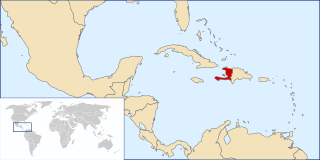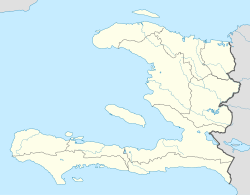
Haiti, officially the Republic of Haiti formerly founded as Hayti, is a country located on the island of Hispaniola in the Greater Antilles archipelago of the Caribbean Sea, to the east of Cuba and Jamaica and south of The Bahamas and the Turks and Caicos Islands. It occupies the western three-eighths of the island which it shares with the Dominican Republic. To its south-west lies the small island of Navassa Island, which is claimed by Haiti but is disputed as a United States territory under federal administration. Haiti is 27,750 square kilometers (10,714 sq mi) in size and has an estimated population of 11.1 million, making it the most populous country in the Caribbean Community (CARICOM) and the second-most populous country in the Caribbean after Cuba.

Although Haiti averages approximately 402 people per square kilometer, its population is concentrated most heavily in urban areas, coastal plains, and valleys. The majority of Haitians, 95%, are of predominantly African descent. But in 2020 with all the emmigration and With all the UN services that have gone in this country, on a number of person DNA test result reveal that they are 80% predominantly African descent with 86% black African 12% European and 2% Native American depending on the department of the country. The remaining of the population is primarily Mulattoes, Europeans, Asians and Arabs. Hispanic residents in Haiti are mostly Cuban and Dominican. About two thirds of the Haitian population live in rural areas.

The Politics of Haiti take place in the framework of a unitary semi-presidential republic, where the president is the head of state and the prime minister is the head of government. The politics of the country are considered historically unstable due to various coup d'états, regime changes, military juntas and internal conflicts. After the deposition of Jean-Bertrand Aristide, however, Haitian politics entered a period of relative democratic stability. The Economist Intelligence Unit rated Haiti a "hybrid regime" in 2019.

A creole language, or simply creole, is a stable natural language that develops from the simplifying and mixing of different languages into a new one within a fairly brief period of time: often, a pidgin evolved into a full-fledged language. While the concept is similar to that of a mixed or hybrid language, creoles are often characterized by a tendency to systematize their inherited grammar. Like any language, creoles are characterized by a consistent system of grammar, possess large stable vocabularies, and are acquired by children as their native language. These three features distinguish a creole language from a pidgin. Creolistics, or creology, is the study of creole languages and, as such, is a subfield of linguistics. Someone who engages in this study is called a creolist.

"La Dessalinienne" is the national anthem of Haiti. It was written by Justin Lhérisson and composed by Nicolas Geffrard.

The Greater Antilles is a grouping of the larger islands in the Caribbean Sea, including Cuba, Hispaniola, Puerto Rico, Jamaica, and the Cayman Islands. Six island states share the region of the Greater Antilles in total, with Haiti and the Dominican Republic sharing the island of Hispaniola. Geologically, the Virgin Islands and Sombrero Island are also part of the Greater Antilles, though politically they are considered part of the Lesser Antilles. At an area of 207,411 square kilometres (80,082 sq mi), not counting the Virgin Islands, the Greater Antilles constitute nearly 90% of the land mass of the entire West Indies, as well as over 90% of its population. The remainder of the land belongs to the archipelago of the Lesser Antilles, which is a chain of islands to the east, running north–south and encompassing the eastern edge of the Caribbean Sea where it meets the Atlantic Ocean, as well as to the south, running east–west off the northern coast of South America. The Lucayan Archipelago is not considered to be a part of the Antilles archipelagos but rather of the North Atlantic.

Haitian Creole is a French-based creole language spoken by 10–12 million people worldwide, and the only language of most Haitians. It is called kreyòl ayisyen or just kreyòl by its speakers, and créole haïtien in Standard French.

The president of Haiti, officially called the president of the Republic of Haiti is the head of state of Haiti. Executive power in Haiti is divided between the president and the government headed by the Prime Minister of Haiti. The current president is Jovenel Moïse, who took office on February 7, 2017.

The culture of Haiti is an eclectic mix of African, Taino and European elements due to the French colonization of Saint Domingue and its large and diverse enslaved African population, as is evidenced in the Haitian language, music, and religion.
A French creole, or French-based creole language, is a creole language for which French is the lexifier. Most often this lexifier is not modern French but rather a 17th-century koiné of French from Paris, the French Atlantic harbors, and the nascent French colonies. French-based creole languages are spoken natively by millions of people worldwide, primarily in the Americas and on archipelagos throughout the Indian Ocean. This article also contains information on French pidgin languages, contact languages that lack native speakers.

Dessalines or sometimes Marchand-Dessalines, is a commune in the Artibonite department of Haiti. It is named after Jean-Jacques Dessalines, a leader of the Haitian Revolution and the first ruler of independent Haiti. It is known as the First Black Capital of the New World.

Haiti has a sizable diaspora, present chiefly in the Dominican Republic, the United States, Canada, Cuba, the Bahamas, and France. They also live in other countries like Belgium, Jamaica, Turks and Caicos, Mexico, U.S. Virgin Islands, Brazil and Chile, among others.

Ouanaminthe is a commune or town located in the Nord-Est department of Haiti. It lies along the Massacre River, which forms part of the natural border between Haiti and the Dominican Republic. Ouanaminthe is the largest commune in northeastern Haiti. The bridge connecting Ouanaminthe to the Dominican city of Dajabón is one of the four main border crossings between the two countries. Throughout its history, the city has repeatedly been a site of conflict in international disputes, first between French and Spanish colonists, and in more modern times as part of the long-standing Haitian-Dominican conflict.
Haitian literature has been closely intertwined with the political life of Haiti. Haitian intellectuals turned successively or simultaneously to African traditions, France, Latin America, the UK, and the United States. At the same time, Haitian history has always been a rich source of inspiration for literature, with its heroes, its upheavals, its cruelties and its rites.

The languages of the Caribbean reflect the region's diverse history and culture. There are six official languages spoken in the Caribbean:

Haitians are the citizens of Haiti and the descendants in the diaspora through direct parentage. An ethno-national group, Haitians generally comprise the modern descendants of self-liberated Africans in the Caribbean territory historically referred to as Saint-Domingue. This includes the mulatto minority who denote corresponding European ancestry, notably from French settlers. By virtue of historical distinction, the vast majority of Haitians share and identify with this common African lineage, though a small number are descendants of contemporary immigrants from the Levant who sought refuge in the island nation during World War I and World War II.
Haitian Cubans are Cuban citizens of full or partial Haitian ancestry.
Mulatto is a term in Haiti that is historically linked to Haitians who are born to one white parent and one black parent, or to two mulatto parents. Contemporary usage of the term in Haiti is also applied to the bourgeoisie, pertaining to high social and economic stature.
Haitian French is the variety of French spoken in Haiti. Haitian French is close to standard French. It should be distinguished from Haitian Creole.













